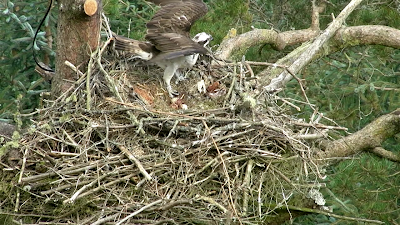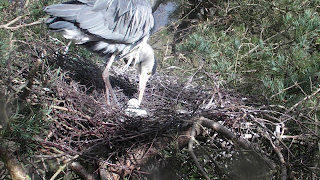 |
| Three tiny osprey chicks hatched |
A hat trick of osprey chicks, have hatched this week. The first osprey chick hatched on 22nd May exactly 40 days since it was laid, followed by the second and then the third chick on consecutive days.
The chicks are so fragile and tiny looking when they first hatch, looking like tiny fluffy ping pong ball heads with the characteristic dark eye-stripe marking their osprey identity.
After hatching, they wobble about and strain to reach up to mum as she leans in to feed them with tiny scraps of raw fish torn straight from the live catch brought in by her faithful partner, white leg ring SS.
After only a couple of days the chicks begin to find strength and they are reaching up and stretching and holding their heads steady, to receive meals. They grow at a phenomenal rate on the diet of raw fish which is superbly rich in protein. Dad will have to work really hard to make sure that he brings in enough fish to feed his family, so that they will become big and strong. He is a very good provider and this is his tenth brood of chicks this year with the same unringed female. They are very experienced parents and they take great care of their young.
Tragedy Strikes
Sadly, the heron family that was on camera with two chicks hatched and one egg still not hatched, has been struck by tragedy. Firstly one chick seemed to have disappeared followed by the second chick gone by the next morning. This just left the single egg and the next day when the cameras came on, even the egg had vanished. We keep seeing the sad parent birds dropping in to the nest and standing and looking but their whole brood for the year have vanished. We did not see what happened but we have witnessed the shadowy black form of a crow lurking in the tree top and it would seem that it must have predated on the young chicks and then returned to take the egg too.
We have often made reference to the contrasting parenting skills of the two species of osprey and heron. Herons make little effort to safeguard their young and leave them for long periods of time which leaves them open to all manner of dangers. The birds have paid a high price this year for their nesting strategy. The ospreys, by comparison are very attentive to their young and there is always one of the parents at the nest to guard their brood. They will see off any threat with tenacity and this has made them the successful breeders that they are on the main nest.
The chicks will grow quickly and the daily family life can be viewed on high definition camera in real time in the two visitor centres of Glentress Wildwatch room in Glentress Forest and in the Osprey and Nature Watch Centre at Kailzie Gardens.
.jpg)


.JPG)





